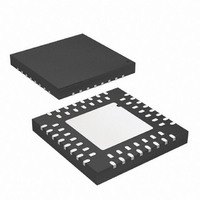ATMEGA169P-16MCH Atmel, ATMEGA169P-16MCH Datasheet - Page 211

ATMEGA169P-16MCH
Manufacturer Part Number
ATMEGA169P-16MCH
Description
MCU AVR 16KB FLASH 16MHZ 64-VQFN
Manufacturer
Atmel
Series
AVR® ATmegar
Datasheet
1.ATMEGA169PV-8AU.pdf
(395 pages)
Specifications of ATMEGA169P-16MCH
Core Processor
AVR
Core Size
8-Bit
Speed
16MHz
Connectivity
SPI, UART/USART, USI
Peripherals
Brown-out Detect/Reset, LCD, POR, PWM, WDT
Number Of I /o
54
Program Memory Size
16KB (8K x 16)
Program Memory Type
FLASH
Eeprom Size
512 x 8
Ram Size
1K x 8
Voltage - Supply (vcc/vdd)
2.7 V ~ 5.5 V
Data Converters
A/D 8x10b
Oscillator Type
Internal
Operating Temperature
-40°C ~ 85°C
Package / Case
64-VQFN Exposed Pad, 64-HVQFN, 64-SQFN, 64-DHVQFN
For Use With
ATSTK600 - DEV KIT FOR AVR/AVR32ATAVRBFLY - KIT EVALUATION AVR BUTTERFLYATSTK502 - MOD EXPANSION AVR STARTER 500ATSTK500 - PROGRAMMER AVR STARTER KIT
Lead Free Status / RoHS Status
Lead free / RoHS Compliant
- Current page: 211 of 395
- Download datasheet (9Mb)
8018P–AVR–08/10
Table 20-2
used for the Shift Register and the 4-bit counter.
Table 20-2.
• Bit 1 – USICLK: Clock Strobe
Writing a one to this bit location strobes the Shift Register to shift one step and the counter to
increment by one, provided that the USICS1..0 bits are set to zero and by doing so the software
clock strobe option is selected. The output will change immediately when the clock strobe is exe-
cuted, that is, in the same instruction cycle. The value shifted into the Shift Register is sampled
the previous instruction cycle. The bit will be read as zero.
When an external clock source is selected (USICS1 = 1), the USICLK function is changed from
a clock strobe to a Clock Select Register. Setting the USICLK bit in this case will select the
USITC strobe bit as clock source for the 4-bit counter (see
• Bit 0 – USITC: Toggle Clock Port Pin
Writing a one to this bit location toggles the USCK/SCL value either from 0 to 1, or from 1 to 0.
The toggling is independent of the setting in the Data Direction Register, but if the PORT value is
to be shown on the pin the DDRE4 must be set as output (to one). This feature allows easy clock
generation when implementing master devices. The bit will be read as zero.
When an external clock source is selected (USICS1 = 1) and the USICLK bit is set to one, writ-
ing to the USITC strobe bit will directly clock the 4-bit counter. This allows an early detection of
when the transfer is done when operating as a master device.
USICS1
0
0
0
1
1
1
1
shows the relationship between the USICS1:0 and USICLK setting and clock source
USICS0
Relations between the USICS1:0 and USICLK Setting
0
0
1
0
1
0
1
USICLK
X
0
1
0
0
1
1
Shift Register Clock Source
No Clock
Software clock strobe
(USICLK)
Timer/Counter0 Compare
Match
External, positive edge
External, negative edge
External, positive edge
External, negative edge
Table
20-2).
4-bit Counter Clock Source
No Clock
Software clock strobe
(USICLK)
Timer/Counter0 Compare
Match
External, both edges
External, both edges
Software clock strobe (USITC)
Software clock strobe (USITC)
ATmega169P
211
Related parts for ATMEGA169P-16MCH
Image
Part Number
Description
Manufacturer
Datasheet
Request
R

Part Number:
Description:
Manufacturer:
Atmel Corporation
Datasheet:

Part Number:
Description:
Manufacturer:
Atmel Corporation
Datasheet:

Part Number:
Description:
IC AVR MCU 16K 16MHZ IND 64-TQFP
Manufacturer:
Atmel
Datasheet:

Part Number:
Description:
IC AVR MCU 16K 16MHZ IND 64-QFN
Manufacturer:
Atmel
Datasheet:

Part Number:
Description:
MCU AVR 16KB FLASH 16MHZ 64TQFP
Manufacturer:
Atmel
Datasheet:

Part Number:
Description:
MCU AVR 16K ISP FLSH 16MHZ 64QFN
Manufacturer:
Atmel
Datasheet:

Part Number:
Description:
IC MCU AVR 16K 16MHZ IND 64QFN
Manufacturer:
Atmel
Datasheet:

Part Number:
Description:
8-bit Microcontrollers - MCU Microcontroller
Manufacturer:
Atmel

Part Number:
Description:
Atmega169p 8-bit Avr Microcontroller With 16k Bytes In-system Programmable Flash
Manufacturer:
ATMEL Corporation
Datasheet:

Part Number:
Description:
IC AVR MCU 16K 16MHZ IND TQFP
Manufacturer:
Atmel
Datasheet:

Part Number:
Description:
IC AVR MCU 16K 16MHZ IND 64-QFN
Manufacturer:
Atmel
Datasheet:











